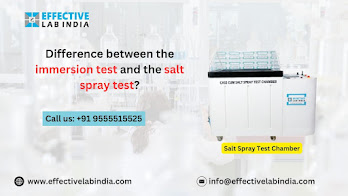Difference Between The Immersion Test And The Salt Spray Test?
Two techniques are used to assess a material's resistance to corrosion, specifically for metals, coatings, and finishes: the immersion test and the salt spray test. Below is a summary of how the two differ from one another:
Type of Exposure:
Immersion Test: This test involves immersing the test specimen for a predetermined amount of time in a corrosive solution, usually water or an electrolyte solution.
In a controlled salt spray chamber, the test specimen is subjected to a continuous or intermittent spray of a saltwater solution, often in the form of a saltwater mist or fog.
Corrosive Agent:
Immersion Test: The material corrodes as a result of a chemical interaction with the fluid it is submerged in. It is possible to select the solution to mimic particular environmental conditions, including saltwater, acidic, alkaline, or other corrosive environments.
Salt Spray Test: Compared to ambient air, the corrosive effect of salt (usually sodium chloride) in the form of a mist or fog speeds up the corrosion process. This is the main cause of the corrosion.
Time and Circumstances:
Immersion Test: Usually carried out over longer periods—days, weeks, or even months—than salt spray experiments. To replicate real-world situations, the test settings could include temperature and agitation fluctuations.
Salt Spray Test: Usually carried out for shorter periods, from a few hours to a few days. Testing standards dictate how the test circumstances, which include temperature, humidity, and salt content, are regulated and standardised.
Application:
Immersion Test: Frequently used to evaluate a material's or coating's overall resistance to corrosion, particularly when it comes to materials meant for extended exposure to corrosive environments like maritime applications.
Salt Spray Test: Often used to quickly assess corrosion resistance, particularly when contrasting various materials or coatings under circumstances that promote corrosion.
Criteria for Evaluation:
Immersion Test: After the test specimen has been submerged for a certain amount of time, the degree and kind of corrosion (such as uniform corrosion or pitting corrosion) are observed.
Salt Spray Test: The corrosion is assessed visually and by measuring the corrosion products (rust, for example) on the specimen's surface. These measurements are frequently made using standardised grading scales or by tracking the corrosion's evolution over time.
while both immersion and salt spray tests evaluate corrosion resistance, they vary in the settings, application, duration, corrosive chemicals used, and assessment standards. These tests are useful testing instruments that support quality control and product development procedures by forecasting how coatings and materials will behave in corrosive environments.
Advancements in Corrosion Testing Techniques: A Comprehensive Overview
A variety of corrosion tests are frequently employed to assess a material's or coating's resistance to corrosion. Among the most well-liked ones are:
- Salt Spray Test (ASTM B117, ISO 9227): This test simulates extreme environmental conditions by subjecting materials to a continuous or sporadic salt spray (fog), which accelerates corrosion. It is frequently employed for rapid corrosion resistance assessments, especially with metallic coatings. A salt spray test chamber provides a controlled atmosphere in which the test is carried out. These chambers guarantee the repeatability and standardisation of test findings by maintaining constant humidity, temperature, and salt content. Typically, the chamber is made up of a salt solution reservoir, a spray nozzle system, controls to adjust humidity and temperature, and an enclosure that is resistant to corrosion.
- Cyclic Corrosion Test (CCT): This entails exposing materials to a variety of corrosive conditions in alternate cycles, including humidity, salt spray, and drying conditions. It is a more faithful simulation of real-world settings than testing using continuous salt spray.
- The ASTM G31 Immersion Test: Involves measures of a material's resistance to corrosion by submerging it for a lengthy amount of time in a corrosive solution, such as water or electrolytes. It's frequently applied to the assessment of materials meant to be submerged in certain settings, such as marine applications.
- Electrochemical Impedance Spectroscopy (EIS): This method determines a material's surface impedance to an alternating current, revealing details on the corrosion processes and resistance. It's applied to corrosion behaviour analysis, both qualitative and quantitative.
- Potentiodynamic Polarisation Test (ASTM G5, ASTM G61): This test plots the polarisation curves of materials to determine how they behave electrochemically. Corrosion rates, corrosion potentials, and other electrochemical characteristics may be found using it.
- The Kesternich Test (ISO 6988, DIN 50018) evaluates a material's resistance to acid corrosion by subjecting it to acidic conditions with elevated sulphur dioxide concentrations. It is frequently employed to assess metallic materials subjected to sulfur-containing industrial atmospheres.
- Profession Test (ASTM D5894): This test assesses the resistance of coated specimens to corrosion and delamination by exposing them to cycles of salt spray, humidity, and dry conditions.
- Humidity Test (ASTM D1748): This test puts materials in high-humidity environments to see how resistant they are to corrosion and deterioration brought on by moisture. It is frequently used to mimic mixed environmental impacts in combination with other corrosion testing.
These corrosion tests vary in their methodologies, test conditions, and applications, but they all play essential roles in assessing the corrosion resistance of materials and coatings in various environments. The selection of a specific test depends on factors such as the intended application, regulatory requirements, and the expected environmental conditions faced by the material.

%20(1).jpg)


Comments
Post a Comment